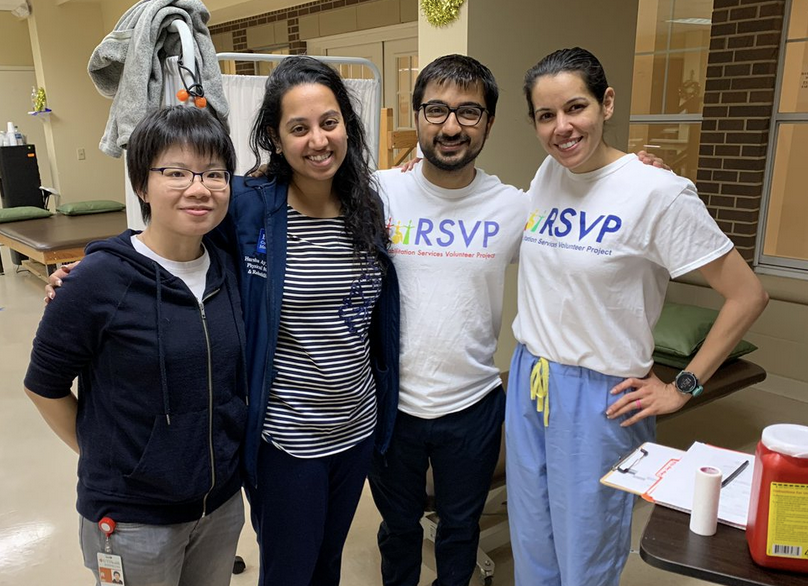
About PM&R

Frequently asked questions
-
A neuromuscular approach to improve lives of patients with disability
In the inpatient setting, someone has a stroke leading to a fall and fracture. Internal medicine can get patients through the stroke, Psychology can help them manage the trauma, Orthopedic surgery fixes their fracture, NOW this is where PM&R comes in. This person wants to go home after getting all this care. But because of their recent surgery, they can’t go up and down stairs safely, they now have limb weakness and need to learn how to use assistive devices to get home living independently again…this is us!
PM&R comes in in the acute rehab specialty to get them to reach their goals
We work closely with other specialties
-
Inpatient settings include, but limited to, acute rehab units and skilled nursing facilities. You’ll a lot of traumatic brain or spinal injuries here. In the outpatient settings, you can do things from Sports Medicine to EMS/NCS
-
4 years medical school
4 years PM&R residency
1 year fellowship (optional)
-
Brain Injury Medicine (or Aquired Brain Injury
Hospice and Palliative Medicine
Neuromuscular Medicine
Pain Medicine
Pediatric Rehabilitation Medicine
Spinal Cord Injury Medicine
Sports Medicine
You can do more fellowships though that are not ACGME accredited but can be just as helpful
-
Our focus is different – for example, we don’t do the exercises nor do we assume that we know the best exercises for patients to do (physical therapists are the ones who train for a long time to get that specialized knowledge!). But we work with the patients so that they are able to do the exercises
o Ashley pointed out that when someone is inpatient (hospitalized) then we can give them injections, manage their medical issues so that they are well enough to engage with therapy services
o In the outpatient setting, we can give people specific injections to help get through pain or give them range of motion to help them engage with therapy services
o I would say in general rehab + therapy are parts of a whole – we’re all needed!
-
We share a lot of patients with orthopedic surgery, sports medicine, and neurology. That means we see a wide RANGE of conditions.
Yue became interested in PM&R through disability medicine and her experience with patients with multiple sclerosis
Roxy became interested in PM&R through pain medicine and her experience with patients with disabilities
Ashley became interested in PM&R through sports medicine and her liking athletics so much!
We all chose PM&R because of lifestyle. It’s a fantastic lifestyle, residency is generally less grueling than other specialities (and we don’t think medicine doesn’t necessarily have to be grueling if you don’t want it).
-
YES all the time
There are a LOT of opportunities for cross collaborations.
Shirley Ryan does some awesome work at their cool labs https://www.sralab.org/
Stanford does a lot of tech collaborations since we’re in Silicon Valley
-
Look at the match list of the medical schools before you go there. That can tell you a lot about how easily it will be to match in certain areas. For example, if a medical school matches a lot of people in dermatology but another one matches 0 in dermatology, then it may be easier to match in dermatology at the first school. If a medical school matches people around the area but not in people around another city, then this is a great fit if you want to stay in the area.
Know how you are evaluated in medical school
Know your goals. If your goal is to work, then the ranking of your medical school does not matter. You want to go to a place with good training. If your goal is to get more fellowship (aka more training), then you probably have to go to a more academically known medical school which typically means a medical school with a higher “ranking”. “Ranking” is usually based on research funding; research is very valued in fellowship so another way of thinking about this is how “academic” you want to be. Is your goal to be a great academic physician, coming up with amazing research contributions? Is your goal to be with your family and be a good doctor?
Ask for help early in college, a lot of other people ask for help! It’s hard to remember this but feel free to ask for help!
Believe in yourself. Confidence is key, and it’s hard to get. Fake it till you make it, it will take you far. Believe in yourself, because you will get there and confidence will make it a LOT easier!
Panels
Interview with University of Washington Residents about the field of PM&R
Watch more of our Panels here or subscribe to our Youtube Channel
People in physiatry
Inspired by Vogue and ND MD, People in Physiatry is a series highlighting the lives and stories of people in the field of Physical Medicine and Rehabilitation (PM&R).



Inspired by Vogue and ND MD, People in Physiatry is a series highlighting the lives and stories of people in the field of Physical Medicine and Rehabilitation (PM&R). In this episode, Vickie Ho, a Speech Language Pathologist in Seattle, describes how SLPs work closely with Physiatrists on rehab teams and comments on issues in diversity and equity that SLPs experience.
Inspired by Vogue and ND MD, People in Physiatry is a series highlighting the lives and stories of people in the field of Physical Medicine and Rehabilitation (PM&R). In this episode, Vickie Ho, a Speech Language Pathologist in Seattle, describes how SLPs work closely with Physiatrists on rehab teams and comments on issues in diversity and equity that SLPs experience.